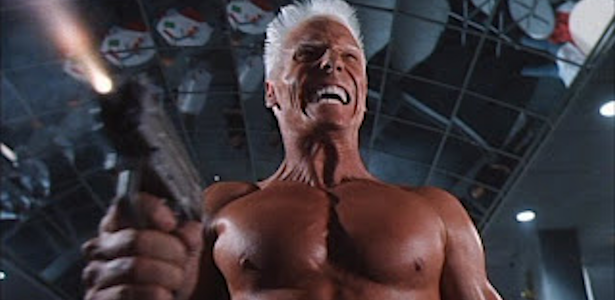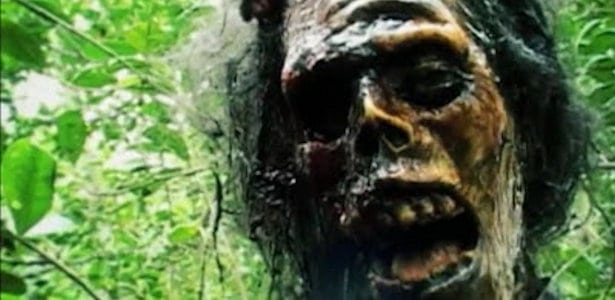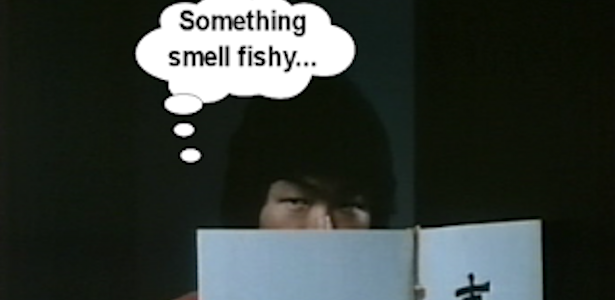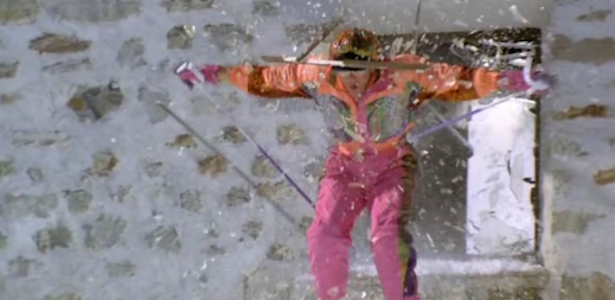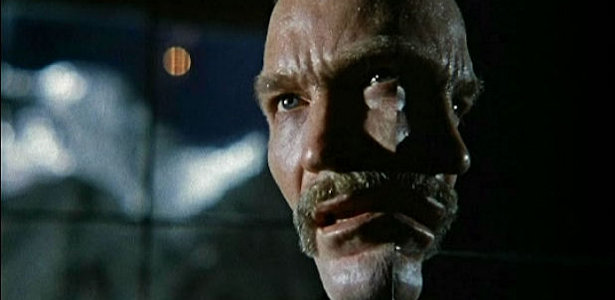As far as horror subgenres go, quite possibly the most erratic and often obscure would be the horror-western. It sounds like such a good idea on paper; Ruthless outlaw back from the dead to take revenge for his execution, terrorizing his killers or their descendants. How could that not be anything but brilliant?
Charles Band's GHOST TOWN (1988) was probably the highest profile attempt, if for no other reason than Fangoria's extensive coverage and New World's extensive distribution. While the sub-genre seems to have flourished in Mexico during the 1960s, it never really did catch on in the rest of the world. Not even here in the US, the birthplace of the western. Even so, it didn't keep a few brave souls from trying.
 Opening in the old west, a homesteader is attempting to settle his patch of land and build a home by shoving a stick into the ground. Gotta start somewhere I guess. A bearded, wild eyed rider (Tag Groat) in a duster rides up and apparently has a beef about who owns the land. When the homesteader asks him where he comes from, the rider snarls "I'm from, where you're going!" Uhhhh, the hardware store? Saskatchewan? Back to sleep? This question is never answered as the rider clumsily draws what appears to be a 12" .45 Long Colt before the homesteader knocks it out of his hand with a shovel (which probably wouldn't have happened if he had a sensible quick draw firearm). It doesn't matter as the rider uses his cavalry saber to skewer the homesteader to his beloved land. He then proceeds to kill some prospectors and a few other random people before the sheriff and his posse catch him chillin' by a campfire, probably tuckered out from all that killin'. The posse lynches him from a tree, but he doesn't die until they fill him full of lead, at which point one of the deputies says "damn he was a weird fella." Of course, he was just playin' possum till they left after which he proceeds to be, as modern poet Brian Johnson once said, slippin' loose from the noose.
Opening in the old west, a homesteader is attempting to settle his patch of land and build a home by shoving a stick into the ground. Gotta start somewhere I guess. A bearded, wild eyed rider (Tag Groat) in a duster rides up and apparently has a beef about who owns the land. When the homesteader asks him where he comes from, the rider snarls "I'm from, where you're going!" Uhhhh, the hardware store? Saskatchewan? Back to sleep? This question is never answered as the rider clumsily draws what appears to be a 12" .45 Long Colt before the homesteader knocks it out of his hand with a shovel (which probably wouldn't have happened if he had a sensible quick draw firearm). It doesn't matter as the rider uses his cavalry saber to skewer the homesteader to his beloved land. He then proceeds to kill some prospectors and a few other random people before the sheriff and his posse catch him chillin' by a campfire, probably tuckered out from all that killin'. The posse lynches him from a tree, but he doesn't die until they fill him full of lead, at which point one of the deputies says "damn he was a weird fella." Of course, he was just playin' possum till they left after which he proceeds to be, as modern poet Brian Johnson once said, slippin' loose from the noose.
 A century later a worker, Ben (Bruce Carson), is loading up his Datsun pick-up with straw bales. Probably infuriated that the ranch hand use something other than an F150, the rider intimidates the man with his long colt, while shouting random things like "you want to cut off my head? Hahahaha!" So threatened by this Ben cringes and squirms on the ground, squealing in a way that sounds something like a cross between Ned Beatty and a tea kettle. Well, what do you expect from a rancher with a Datsun? Machismo?
A century later a worker, Ben (Bruce Carson), is loading up his Datsun pick-up with straw bales. Probably infuriated that the ranch hand use something other than an F150, the rider intimidates the man with his long colt, while shouting random things like "you want to cut off my head? Hahahaha!" So threatened by this Ben cringes and squirms on the ground, squealing in a way that sounds something like a cross between Ned Beatty and a tea kettle. Well, what do you expect from a rancher with a Datsun? Machismo?
A group of couples are headed out to that very same dude ranch (presumably a ranch populated with retired surfers) for a little vacation. Things start out a little off, as the ranch is basically a ramshackle house with some horses and a guest house in which Ben, now catatonic from his experience, lives with his wife. For some reason the owner of the ranch won't tell them how much their vacation is going to cost, but ranch hand crazy Zeb (Wayne Douglass) know's that it's got a death cur - I mean he knows that "they're going to be real sorry!"
 As it turns out, one of the guys, Tom (Rick Groat, who also co-produced and coordinated the stunts), is related to the original homesteader from the beginning of the film which means he has a special interest in the legend of the Rider. Zeb finally spills the beans to the rest of the group by telling a story of how terrifying the rider was when he ran into him as a kid. "He sat on his horse - he just stood there!" says Zeb. Yessir, that's enough to drive any man plum loco, I reckon.
As it turns out, one of the guys, Tom (Rick Groat, who also co-produced and coordinated the stunts), is related to the original homesteader from the beginning of the film which means he has a special interest in the legend of the Rider. Zeb finally spills the beans to the rest of the group by telling a story of how terrifying the rider was when he ran into him as a kid. "He sat on his horse - he just stood there!" says Zeb. Yessir, that's enough to drive any man plum loco, I reckon.
Yep, the rider (who is never given a name) is back. Back in... err, beige, and he's not too pleased with having even more idiots on his land. Not that you'd know he was displeased since he spends most of the time smiling and laughing. Of course it has been a long standing medical fact that laughter and smiles are the easiest way to strike terror into the hearts of mere mortals.
The second half of the film is essentially a reworking of NIGHT OF THE LIVING DEAD, except without the gore, the stark cinematography, the sense of impending doom and generally everything that made it scary. After a few of the couples are gunned down, the rest barricade themselves in the ranch house while the rider demands from horseback that they come outside. Why he didn't go into the house and get them is never explained. Since he can't be killed by anything but decapitation with his own cavalry sword, I have to assume that he couldn't get in because his horse wouldn't fit through the door.
 While the film falls flat on the whole "slashing" part of a slasher movie (the effects are limited to some quick shots of victims with blood splashed on them and a plethora of dry squibs), and it blows the T and A quotient by having not one, but two shower scenes in which only the quickest of glimpses of nudity, the film is pretty damned entertaining due to the incredibly amusing dialogue. In one scene "Type A" assnugget Buddy (David Campbell) yells at the shellshocked Ben, who is recounting his horrifying experience with his wife, saying "I hate to break up this skintillating conversation!" No hipster irony here. The guy actually says "skin-tillating". Then there is a scene, while another couple are embracing in their room, the woman looks into her man's eyes and says "do long rides make you horny?" How is a man supposed to answer that? If you say "yes" you are some sort of creepy weirdo, and if you say "no" she will think that you aren't interested in her. Damn woman questions.
While the film falls flat on the whole "slashing" part of a slasher movie (the effects are limited to some quick shots of victims with blood splashed on them and a plethora of dry squibs), and it blows the T and A quotient by having not one, but two shower scenes in which only the quickest of glimpses of nudity, the film is pretty damned entertaining due to the incredibly amusing dialogue. In one scene "Type A" assnugget Buddy (David Campbell) yells at the shellshocked Ben, who is recounting his horrifying experience with his wife, saying "I hate to break up this skintillating conversation!" No hipster irony here. The guy actually says "skin-tillating". Then there is a scene, while another couple are embracing in their room, the woman looks into her man's eyes and says "do long rides make you horny?" How is a man supposed to answer that? If you say "yes" you are some sort of creepy weirdo, and if you say "no" she will think that you aren't interested in her. Damn woman questions.
Feeling like a shot-on-video production, even though it was shot on 35mm, DEVIL RIDER was produced by Merlin Miller and starred Tag Groat, giving it the distinction of having the most entertaining credited names in a movie, ever. Director Victor Alexander got his start in the camera and electrical department on Tobe Hooper's EATEN ALIVE (1977) and was editor of David A. Prior's KILLZONE (1985), but apparently only directed three films. His other two, SURVIVAL (1985) and TIGER CAGE (2012), barely have entries in the IMDb. The odd thing about this is that in spite of the distributor, Magnum Entertainment, being a small label, they put out some choice genre offerings (including the first ever uncut version of SUSPIRIA in the US), theatrically and on video since the mid 1960s. While their titles were strictly cult movies, they did well enough to have a handful of tapes in pretty much every video store in the US. In the early '90s, they started a short-lived M2 label for even smaller, direct to video productions. The titles on the M2 label are the hardest to come by, which is maybe why DEVIL RIDER is incredibly obscure. Or maybe it's just because it is only entertaining in an extremely forgiving state of mind.
Charles Band's GHOST TOWN (1988) was probably the highest profile attempt, if for no other reason than Fangoria's extensive coverage and New World's extensive distribution. While the sub-genre seems to have flourished in Mexico during the 1960s, it never really did catch on in the rest of the world. Not even here in the US, the birthplace of the western. Even so, it didn't keep a few brave souls from trying.
 Opening in the old west, a homesteader is attempting to settle his patch of land and build a home by shoving a stick into the ground. Gotta start somewhere I guess. A bearded, wild eyed rider (Tag Groat) in a duster rides up and apparently has a beef about who owns the land. When the homesteader asks him where he comes from, the rider snarls "I'm from, where you're going!" Uhhhh, the hardware store? Saskatchewan? Back to sleep? This question is never answered as the rider clumsily draws what appears to be a 12" .45 Long Colt before the homesteader knocks it out of his hand with a shovel (which probably wouldn't have happened if he had a sensible quick draw firearm). It doesn't matter as the rider uses his cavalry saber to skewer the homesteader to his beloved land. He then proceeds to kill some prospectors and a few other random people before the sheriff and his posse catch him chillin' by a campfire, probably tuckered out from all that killin'. The posse lynches him from a tree, but he doesn't die until they fill him full of lead, at which point one of the deputies says "damn he was a weird fella." Of course, he was just playin' possum till they left after which he proceeds to be, as modern poet Brian Johnson once said, slippin' loose from the noose.
Opening in the old west, a homesteader is attempting to settle his patch of land and build a home by shoving a stick into the ground. Gotta start somewhere I guess. A bearded, wild eyed rider (Tag Groat) in a duster rides up and apparently has a beef about who owns the land. When the homesteader asks him where he comes from, the rider snarls "I'm from, where you're going!" Uhhhh, the hardware store? Saskatchewan? Back to sleep? This question is never answered as the rider clumsily draws what appears to be a 12" .45 Long Colt before the homesteader knocks it out of his hand with a shovel (which probably wouldn't have happened if he had a sensible quick draw firearm). It doesn't matter as the rider uses his cavalry saber to skewer the homesteader to his beloved land. He then proceeds to kill some prospectors and a few other random people before the sheriff and his posse catch him chillin' by a campfire, probably tuckered out from all that killin'. The posse lynches him from a tree, but he doesn't die until they fill him full of lead, at which point one of the deputies says "damn he was a weird fella." Of course, he was just playin' possum till they left after which he proceeds to be, as modern poet Brian Johnson once said, slippin' loose from the noose. A century later a worker, Ben (Bruce Carson), is loading up his Datsun pick-up with straw bales. Probably infuriated that the ranch hand use something other than an F150, the rider intimidates the man with his long colt, while shouting random things like "you want to cut off my head? Hahahaha!" So threatened by this Ben cringes and squirms on the ground, squealing in a way that sounds something like a cross between Ned Beatty and a tea kettle. Well, what do you expect from a rancher with a Datsun? Machismo?
A century later a worker, Ben (Bruce Carson), is loading up his Datsun pick-up with straw bales. Probably infuriated that the ranch hand use something other than an F150, the rider intimidates the man with his long colt, while shouting random things like "you want to cut off my head? Hahahaha!" So threatened by this Ben cringes and squirms on the ground, squealing in a way that sounds something like a cross between Ned Beatty and a tea kettle. Well, what do you expect from a rancher with a Datsun? Machismo?A group of couples are headed out to that very same dude ranch (presumably a ranch populated with retired surfers) for a little vacation. Things start out a little off, as the ranch is basically a ramshackle house with some horses and a guest house in which Ben, now catatonic from his experience, lives with his wife. For some reason the owner of the ranch won't tell them how much their vacation is going to cost, but ranch hand crazy Zeb (Wayne Douglass) know's that it's got a death cur - I mean he knows that "they're going to be real sorry!"
 As it turns out, one of the guys, Tom (Rick Groat, who also co-produced and coordinated the stunts), is related to the original homesteader from the beginning of the film which means he has a special interest in the legend of the Rider. Zeb finally spills the beans to the rest of the group by telling a story of how terrifying the rider was when he ran into him as a kid. "He sat on his horse - he just stood there!" says Zeb. Yessir, that's enough to drive any man plum loco, I reckon.
As it turns out, one of the guys, Tom (Rick Groat, who also co-produced and coordinated the stunts), is related to the original homesteader from the beginning of the film which means he has a special interest in the legend of the Rider. Zeb finally spills the beans to the rest of the group by telling a story of how terrifying the rider was when he ran into him as a kid. "He sat on his horse - he just stood there!" says Zeb. Yessir, that's enough to drive any man plum loco, I reckon.Yep, the rider (who is never given a name) is back. Back in... err, beige, and he's not too pleased with having even more idiots on his land. Not that you'd know he was displeased since he spends most of the time smiling and laughing. Of course it has been a long standing medical fact that laughter and smiles are the easiest way to strike terror into the hearts of mere mortals.
The second half of the film is essentially a reworking of NIGHT OF THE LIVING DEAD, except without the gore, the stark cinematography, the sense of impending doom and generally everything that made it scary. After a few of the couples are gunned down, the rest barricade themselves in the ranch house while the rider demands from horseback that they come outside. Why he didn't go into the house and get them is never explained. Since he can't be killed by anything but decapitation with his own cavalry sword, I have to assume that he couldn't get in because his horse wouldn't fit through the door.
 While the film falls flat on the whole "slashing" part of a slasher movie (the effects are limited to some quick shots of victims with blood splashed on them and a plethora of dry squibs), and it blows the T and A quotient by having not one, but two shower scenes in which only the quickest of glimpses of nudity, the film is pretty damned entertaining due to the incredibly amusing dialogue. In one scene "Type A" assnugget Buddy (David Campbell) yells at the shellshocked Ben, who is recounting his horrifying experience with his wife, saying "I hate to break up this skintillating conversation!" No hipster irony here. The guy actually says "skin-tillating". Then there is a scene, while another couple are embracing in their room, the woman looks into her man's eyes and says "do long rides make you horny?" How is a man supposed to answer that? If you say "yes" you are some sort of creepy weirdo, and if you say "no" she will think that you aren't interested in her. Damn woman questions.
While the film falls flat on the whole "slashing" part of a slasher movie (the effects are limited to some quick shots of victims with blood splashed on them and a plethora of dry squibs), and it blows the T and A quotient by having not one, but two shower scenes in which only the quickest of glimpses of nudity, the film is pretty damned entertaining due to the incredibly amusing dialogue. In one scene "Type A" assnugget Buddy (David Campbell) yells at the shellshocked Ben, who is recounting his horrifying experience with his wife, saying "I hate to break up this skintillating conversation!" No hipster irony here. The guy actually says "skin-tillating". Then there is a scene, while another couple are embracing in their room, the woman looks into her man's eyes and says "do long rides make you horny?" How is a man supposed to answer that? If you say "yes" you are some sort of creepy weirdo, and if you say "no" she will think that you aren't interested in her. Damn woman questions.



